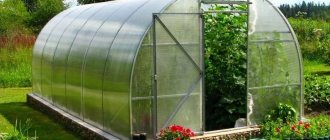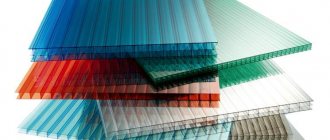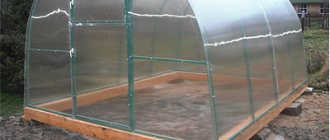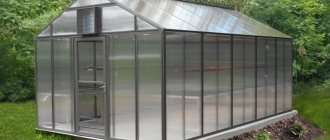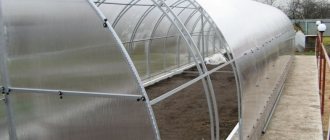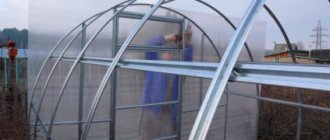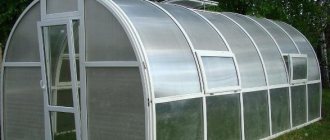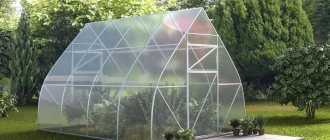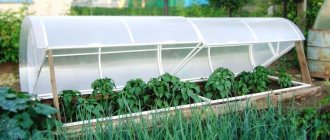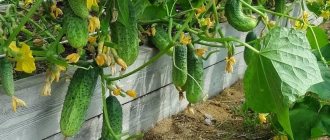Some important parameters
Like any other engineering structure, such a greenhouse has both strengths and weaknesses. Its obvious advantages include the following characteristics:
- Light weight.
- Effective thermal insulation.
- Transparency sufficient for complete photosynthesis and crop ripening.
- Resistance to climate damage.
- Harmless to humans and plants.
- Possibility of scaling.
- Elementary installation.
Due to the fact that polycarbonate sheets can have different prices, depending on the quality, in some cases it becomes possible to significantly save on the material. The second option to save money is to select thinner sheets of polymer.
Polycarbonate also has an obvious drawback. It consists of vulnerability to exposure to sharp objects. That is why, in order to preserve the aesthetic qualities of the greenhouse, you should use pruners, knives and a sharpened hoe in it as carefully as possible.
Tips for use
After you have purchased and installed the Dachnaya-Dvushka greenhouse on your site, take care of its proper operation. If you follow all the rules and regulations, the structure will last quite a long time.
- The greenhouse should be located away from roofs and trees so that nothing falls on top of it and causes damage to the coating. The minimum distance from it and other objects should be 2 m.
- Polycarbonate is usually not removed from the greenhouse for the winter, but in regions where there is a large amount of precipitation, snow should be regularly removed from the surface of the structure. Also make sure that the snow does not put pressure on the side walls of the greenhouse.
Use brooms to clean the greenhouse
"Dachnaya-Dvushka"
“Dachnaya-Dvushka” is an excellent option for plots of modest size. Reliable, strong, durable and relatively inexpensive - these are its main positive qualities. And it is quite possible to grow a decent harvest in it. So feel free to buy “Dvushka” and enjoy growing your favorite vegetables.
Greenhouse size 2 by 3
The 2x3 greenhouse structure is a compact garden building with a polycarbonate top and has the following characteristics:
- Length - 3 m;
- Width - 2 m;
- Height - 1.9 m;
- The frame is galvanized rectangular steel with a wall thickness of 1.2 mm;
- Fixation is carried out using steel fasteners.
No. 5. Which foundation for a greenhouse is better?
Depending on the objectives pursued, choose one of the following foundation options:
- tape , which is organized using concrete, less often sleepers, brick or gravel. Previously, the arrangement of such a foundation was considered mandatory, but is still carried out by many summer residents. The construction is almost permanent; it will be impossible to move it to another place;
- the block foundation is made of reinforced concrete blocks, it is suitable for regions with loose soil;
- pile and point foundations are easy to install and allow you to build a strong, reliable greenhouse;
- timber foundations have recently been used more and more often; they can be equipped even by not the greatest professional in the construction industry. The tree will require pre-treatment with antiseptics, but a greenhouse with such a foundation can be easily moved from one place to another - ideal for growing vegetables.
Greenhouse size 3 by 4
These are the best greenhouse sizes for a summer cottage with small garden plots. For the convenience of the vegetable grower, the greenhouse has two doors and two windows.
The parameters of this structure are as follows:
- 3 m wide;
- 2.1 m high;
- 4 m long.
Material from which the greenhouse is built
A greenhouse frame made of wood is not only a generally affordable material, but also a material that has useful properties. Wood has low thermal conductivity, and wooden materials are easy to process. At the same time, there are also disadvantages - the short service life of wood due to high humidity and at the same time high temperature, all this is very typical for summer greenhouses.
In winter, the moistened wood of the greenhouse frame is subjected to severe frost testing. Regular painting does not help; it quickly crumbles over time. Special antiseptics used for wood help a lot. They protect against high humidity and temperature, and also have antimicrobial properties.
It must be remembered that under operating conditions of a greenhouse, some antiseptics are toxic indoors at high temperatures; this can cause allergies and headaches.
Greenhouse size 3 by 6
Garden greenhouses of the specified dimensions are erected on arched structures. The resulting configuration provides the structure with good aerodynamics, increased resistance to deformation and favorable aesthetics.
This model has the following parameters:
- Width - 3 m;
- Length - 6 m;
- Height - 2 m;
- Iron frame 0.7 mm thick;
- Two doors and vents for ventilation.
Features of installing a polycarbonate-based greenhouse with your own hands
Assembling a polycarbonate greenhouse is not difficult. Usually the manufacturer, along with the parts, provides detailed instructions on how to do this. A simple small structure without pouring a foundation can be assembled by 2 people in 1–2 days, using only a screwdriver or a screwdriver. Most summer residents cope with this task without resorting to professional help.
Video: Assembling a polycarbonate greenhouse
We propose to consider the installation features of one of the most popular models among summer residents - “Sotka”. This is an arched structure with dimensions 4 (6.8) × 3 × 2.15 made of a V-shaped profile made of galvanized steel with a thickness of 0.8 mm. It has 2 doors with windows. The frame can be further strengthened and the length increased. A foundation is not needed for such a structure. However, in order for it to last for a long time, it is better to make a wooden frame or strip foundation.
The total weight of the structure is 60 kg, the disassembled length is 1.7 m.
Important! The installation of the greenhouse must be planned for a period when the air temperature is +10...+12°C. When installed in cold weather, the plastic bends, and later, when it gets warmer, it expands, which negatively affects the mounting points and requires additional sealing.
In order to assemble the greenhouse, you need to perform the following steps:
- Unpack the parts (frame, washers, fasteners, metal corners, tape) and read the instructions.
- Place them on the site where the structure is planned to be installed. It should be level and well lit. There must be a minimum distance of 2 m from permanent buildings.
- Attach the arcs to the foundation with anchor bolts or to the ground, digging into their base. The frame must stand firmly and not wobble.
- Connect them using crossbars.
- Attach doors and windows.
- Cut polycarbonate into the required sizes and shapes using a jigsaw or metal file.
- Attach the honeycomb carbonate sheets to the frame using galvanized tie tape. If the thickness of the sheets is 6–8 mm, then they can be overlapped; thicker polycarbonate can only be attached end-to-end.
- Secure the sheets at the base.
- Fix polycarbonate on doors and windows.
- Seal the joints using sealant or aluminum tape.
- If necessary, touch up unsightly elements with special paint for polycarbonate.
Video: Instructions for assembling the Sotka greenhouse
The most suitable greenhouse dimensions
It is generally accepted that at the dacha it is best to install a greenhouse structure made of polycarbonate, the dimensions of which are 6x3.
Despite its considerable dimensions, such a structure made of sheet building materials compares favorably with its analogues in terms of convenience and economic efficiency.
No. 10. The best greenhouse manufacturers
The secret to choosing a high-quality greenhouse is simple: do not buy at too low prices (often these are Chinese-made products of very low quality) and trust large manufacturers, and it is advisable to contact a company store or the company’s website, and not an intermediary. Little-known fly-by-night companies are not the best option - they may close soon, you won’t be able to file a claim against them, and you won’t be able to buy a new greenhouse with the couple of thousand rubles you saved.
Among those presented on the domestic market, the products of such companies perform best:
- Volya is the largest domestic enterprise in the sector, operating since 1993, producing polycarbonate greenhouses, film greenhouses, various materials and accessories for greenhouses, as well as industrial greenhouses and a number of related products and irrigation systems;
- produces only polycarbonate greenhouses. The frame is distinguished by a reliable zinc coating, firmly welded, polycarbonate is represented by products from different manufacturers. Product warranty 7 years;
- “Factory of ready-made greenhouses” has its own production of polycarbonate with a thickness of 4 to 16 mm and steel square pipe. Warehouses are located in all regions of the country;
- “People's Greenhouse Plant” independently produces a metal square pipe for constructing a frame; ready-made greenhouses are completed with domestically produced polycarbonate 4-10 mm thick with a protective coating. The range also includes a number of related products;
- "Rus-Teplitsa" offers easy-to-install greenhouses made of painted and galvanized pipes coated with polycarbonate;
- "Greenhouses of the North" . The company has been operating since 2010, producing frames made of galvanized profiles coated with polycarbonate in various shapes and sizes.
The selection of ready-made greenhouses is impressive, and gardeners with “hands on” can try to build a greenhouse themselves. Be that as it may, when choosing and constructing a greenhouse, take into account the nuances described above.
The article was written for the site.
Tags:Greenhouse
Greenhouse dimensions 3x6
- it is completely suitable for growing vegetables in commercial quantities;
- the structure remains effective no matter how much the air temperature outside the greenhouse drops;
- The metal frame ensures tight fixation of all components, while the polymer sheets do not tear even under strong tension.
No. 7. Greenhouse shape
To ensure a good harvest, it is not enough to choose a suitable frame and covering material; you also need to find the optimal shape. The most common options:
- arched greenhouses , as well as domed and teardrop-shaped ones, retain heat well, are easy to arrange, do not contain sharp corners, therefore they require much less covering material, and precipitation does not linger on them. Such structures can be transformed, but they are limited in the choice of coating - mainly polycarbonate is used. In addition, access to the outer beds will be difficult;
- greenhouses with a gable roof will require more material for arrangement, but the area for planting in them is significantly larger. The design provides excellent lighting even under cloudy skies, withstands snow loads well, but is more expensive than the arched one;
- lean-to greenhouses are often installed near the wall of the house, which allows for significant savings. It is better to direct the roof slope to the south side;
- A pyramid greenhouse is an option for those who love everything unusual. The designs are complex in execution and are in demand among gardeners;
- a polygonal greenhouse is an impressive and expensive structure, but due to the presence of a large number of sides, the structure warms up well at any time of the day.
Features of the greenhouse
- do not require daily careful maintenance;
- withstands long periods of cold weather and extreme heat (in the temperature range from - 50 to + 60);
- easy to transport when disassembled;
- sold at an affordable price;
- allow the use of a two-layer cover, which allows for reliable thermal insulation of the structure;
- easy to assemble, for which a simple tool is sufficient.
No. 6. Types of greenhouse coverings
It is easy to notice that the largest area of the greenhouse is occupied by the covering material, so summer residents pay maximum attention to its choice. Currently the following materials are actively used:
- regular and reinforced polyethylene film;
- glass;
- polycarbonate
Each of these materials copes with its direct functions differently.
Glass cover
Previously, glass was almost the only suitable material for arranging a greenhouse. Today everything has changed, but it continues to be used due to the following advantages :
- good light transmittance;
- high thermal insulation characteristics;
- resistance to temperature changes and chemicals;
- durability;
- aesthetics.
Minuses:
- heavy weight, requiring a very good frame;
- fragility. Hail can damage the material, and using laminated or tempered glass is too expensive;
- long and labor-intensive installation process;
- lack of a filter against infrared radiation, which can be harmful to some plants.
Glass is chosen with a thickness of at least 4 mm . The larger the sheets, the higher the light transmission (the area of the frame decreases), but the higher their fragility.
Polyethylene coating
It’s worth taking a look at any dacha cooperative to notice that plastic film is most often used to equip greenhouses.
Advantages:
- good light transmission and the ability to softly diffuse light;
- low price;
- ease of use and low weight;
- protection of plants from light frosts (down to -30C);
- Suitable for greenhouses of any shape.
Flaws:
- rapid wear, especially at fastening points, so the film will have to be changed every year;
- accumulation of condensation film on the surface, which can lead to a number of diseases in plants.
For the low price and ease of use, summer residents forgive polyethylene for its fragility.
If you look at it, the material is presented on the market in several varieties:
- ordinary polyethylene film . Sold in rolls 120-300 cm wide, it requires special care when installing on a frame, since the slightest cut can soon increase significantly. It is better to seal especially dangerous places with tape to guarantee;
- PVC film is more expensive than polyethylene film, but is much stronger, can last 5-7 years, retains heat accumulated during the day well, and blocks infrared rays;
- reinforced polyethylene film can serve for several seasons in a row, as it is equipped with an internal frame made of fiberglass, polypropylene, twisted polyethylene or other materials. Can withstand hail and strong winds.
Polycarbonate cover
The most modern and price- and quality-balanced material for covering greenhouses is cellular polycarbonate. Please note that there is also monolithic polycarbonate on the market, but it is not suitable for greenhouses. Cellular polycarbonate has a special structure: inside it there are partitions (honeycombs) filled with air. This structure provides many advantages:
- high strength, 200 times higher than that of glass. Rain, strong wind and even hail will not harm polycarbonate;
- excellent light transmission and much better heat retention abilities than glass;
- ease of work, since the material bends well, is easy to cut and drill, and is light in weight;
- relative durability (up to 15 years);
- great appearance.
When choosing polycarbonate for a greenhouse, you should pay attention to the thickness : it should be at least 4 mm , and preferably 6 mm; for arranging the roof of a greenhouse, it is better to look for sheets 7-8 mm thick. Without special protection, the material does not withstand sunlight well, so there must be a protective layer - do not believe sellers who talk about using protective additives in bulk, this is all short-lived material. When heated, polycarbonate tends to expand, so experienced specialists recommend installation at a temperature of at least +100C and fastening the sheets overlapping.
Other materials for covering greenhouses
The following materials can also be used to cover the greenhouse:
- spunbond is a non-woven material obtained from a polymer melt with the addition of stabilizers for resistance to ultraviolet rays. This is a dense white fabric, often called agrofibre. It has good strength, light transmission, high thermal insulation properties, is resistant to rotting, temperature changes and chemicals, and will last up to 5 seasons;
- plexiglass is a durable material, suitable for northern snowy regions. The downside is the high price;
- Fiberglass is made from polyester resins, reinforced with reinforcement, and retains heat well.
Extended greenhouse option
Popular greenhouse sizes are also the variety with sides of 3 and 8 meters. In addition to the above parameters, it has the following characteristics:
- Height - 2 m;
- Galvanizing of frame parts;
- The distance between the arches is 65 cm;
- The structure does not need painting.
This design provides for the presence of two doors and windows, the use of various types of fittings and fastening components.
Assembly instructions
It is important to assemble the “Dachnaya-Dvushka” strictly according to the instructions, otherwise the structure will last significantly less time than a properly assembled greenhouse. You should also be sure to work with gloves, since most of the structural parts have sharp corners and edges that can easily injure your hands. So, let’s begin the installation of “Dachnaya-Dvushka”.
Step 1: Unpack the included parts bags. Please note: all parts are numbered, which greatly simplifies the process of assembling the structure.
Unpacking greenhouse parts
Step 2. Start assembling the greenhouse with power arcs. To do this, first connect parts 4b and 4n to each other - you will get a “dome” of the power arc. In this way, assemble all the upper parts of the arcs that are included in the kit.
Assembly of the power arc
Step 3. Then screw the racks to the lower parts of the resulting elements (part 1).
Attaching the racks
Step 4: Take the foundation posts (24) and screw them to the bottom edge of the regular posts.
Step 5. The supports (part 3), in turn, connect to the fundamental posts.
Step 6. You have received the required number of fully assembled arcs for the greenhouse. Now some of them need to be strengthened. Take horizontal ties (22), strut parts (23), radial ties (25) and corner braces (26). Using a horizontal tie, connect two half-arcs 4n and 4v at the top.
Connection of two half-arcs
Step 7. Install the struts parallel to the “wall” arc, reinforcing them with radial ties in the middle. The tie connects the strut and the arc.
Connection of arc and strut
Step 8. Attach the corner arcs to the corner of the connection between the strut and the horizontal tie. Thus, we get fully assembled power arcs.
Attaching the power arc to the corner of the connection between the strut and the horizontal tie
Step 9. In the same way, only without struts and ties, assemble the end arches.
Step 10. Start assembling the ends. Take the vertical parts of the doorway 9-1, 9-2, connect them together and screw them to the upper outermost arches 4vk.
Assembling the end of the greenhouse
Step 11. Attach the horizontal parts of the doorway 10 and the end connecting parts 8 to the verticals.
End connecting parts are attached to the verticals
Step 12. Attach foundation posts and supports to the bottom of the end arches.
Attaching foundation posts and supports to the bottom of the end arches
Step 13. Connect the end and power arcs together using the outer (2k) and main (2) runs.
Connection of power and end arcs
Step 14. Connect all assembled power and end arcs into a single structure.
Assembly of arcs into a single structure
Step 15. Attach purlins to all points marked on the diagram.
Step 16. Dig a trench 30 cm deep in the place where the greenhouse will be installed.
Trench for greenhouse
Step 17. Place the T-shaped ends of the structure into the trench and level the greenhouse.
Checking with a level
Step 18: Dig the trench.
The trench is being dug in
Step 19. Start assembling the doors and vents. Take vertical parts of doors 12dp, horizontal parts of doors and end windows 14m and diagonals of end windows and doors 13m. Connect together as shown in the figure.
Door assembly diagram
Window assembly diagram
Step 20. Connect the vertical parts of the 12fl end vents and the vertical parts of the 12fl end vents with a diagonal of 14 m.
Connection of the upper parts of the end vents
Step 21. Cover the doors and vents. Using clamps and washers, secure the piece of polycarbonate to the door.
Polycarbonate door trim
Attention! Don't forget to tape the ends of the polycarbonate sections with tape.
Step 22. Attach the hinge seal to the door where the awnings will be installed.
Attaching the loop seal
Step 23. Secure the door seal around the perimeter of the door.
Attaching the door seal
Step 24. Sheathe the window in the same way. Fix a 14m diagonal on top of the reinforced polycarbonate.
Diagonal on the window
Step 25. Attach the door hinges directly to the door itself.
Attaching door hinges
Step 26. Start cutting the polycarbonate as shown in the picture.
Polycarbonate cutting diagram
Attention! Remember that the transport film is removed only before the sheet is secured to the frame. The polycarbonate is attached with the UV protected side up.
Step 27. Cover the ends of the greenhouse with polycarbonate.
Sheathing the ends with polycarbonate
Step 28: Install the end seal.
Attaching the end seal
Step 29. Cover the entire greenhouse with polycarbonate, securing it with washers. The greenhouse is ready.
Greenhouse "Dachnaya-Dvushka". Assembly instructions. Downloadable file (click the link to open the PDF in a new window).
Assembly instructions
Video – Assembling the “Dachnaya-Dvushka” greenhouse
Selection of materials
When choosing a polycarbonate sheet, you should focus on two important parameters - its color and thickness. A thin sheet will not fit the metal frame as smoothly as a thick one, so for connoisseurs of graceful forms it makes sense to choose a thicker shell. The best solution in this case is a two-layer coating of the greenhouse frame.
The need for a foundation for a greenhouse structure is determined by its volume. If the owner’s choice fell on a low greenhouse, reminiscent of a bread box, then it can be installed without a base.
If you decide to install a high greenhouse on the site, then you will need wood or brick as the material for the foundation.
No. 2. Where to put the greenhouse?
Choosing a location for a greenhouse is a question no less important than selecting the most suitable design. If the greenhouse is placed incorrectly on the site, the money for its purchase and installation can be considered wasted, as well as the efforts to grow plants. When choosing the optimal location for a greenhouse, it is worth considering the following factors:
- Light level is a key parameter when finding a suitable location. the maximum possible amount of light during the day and not be shaded by trees or houses. Otherwise, the cost of artificial lighting will increase, but it will not help grow crops in the expected volume. Experts advise positioning the greenhouse so that one end faces the west and the other faces the east. With this arrangement it is possible to achieve maximum illumination. If plants will be grown in winter, then artificial lighting will not be possible, so it will be necessary to think through the installation of communications in advance;
- winds _ The greenhouse must be placed in the calmest and quietest place on the site , protected from winds and drafts, because they will significantly cool the structure, which will lead to serious heating costs in the winter season. A nearby house can provide good protection from the winds, but it will cast a shadow, so it is best to protect the greenhouse with a hedge or a low-height blind fence located at a distance (for example, for a greenhouse 2-2.5 m high, the hedge can be placed at a distance 7-7.5 m);
- relief and soil type . The greenhouse must be placed only on a level place ; if there is none, then the ground will have to be artificially leveled. Sandy and swampy soils, like lowlands, are not suitable for placing greenhouses, and clay soil will need to be covered with gravel first, and only then with a layer of fertile soil;
- convenience of placement .
Many summer residents place greenhouses on the outskirts of their plot. This is justified if, according to all other factors, this is the most suitable place. The farther the greenhouse is located, the less convenient it will be to maintain and the more expensive it will be to connect all communications. Places where you should not install a greenhouse
Dimensions and polymer thickness
It is believed that cellular polycarbonate is the best for greenhouses. This polymer has a hollow structure, which significantly reduces the load on supporting structures. The size of a polycarbonate sheet for greenhouses is determined by its thickness.
In order to prevent excessive scraps when cutting polycarbonate sheets, the following considerations must be taken into account:
- The length of the frame arches can be three, four, six, twelve meters;
- The flexibility of the selected sheet affects how it will fit the frame elements. Accordingly, when purchasing thick polycarbonate, it is necessary to provide some extra length, which is unlikely to be needed for a sheet of small thickness.
Which polycarbonate should be used for a greenhouse
The coating is of great importance for the performance characteristics of the greenhouse. When choosing polycarbonate for a greenhouse, the following parameters must be taken into account: type of polycarbonate; the presence of a light-stabilizing layer; material thickness.
Polycarbonate type
Today there are two types of polycarbonate on the market - cellular and monolithic. Among these materials, cellular polycarbonate has the best characteristics for use as a roofing material for a greenhouse.
Cellular polycarbonate is a sheet material from the group of thermoplastics, consisting of two or more layers with longitudinal internal jumpers. This board structure provides excellent technical characteristics and performance properties of the material.
The most significant of them when constructing a greenhouse are the following:
Low specific gravity
High thermal resistance
High light transmission
High flexibility
Resistance to climatic conditions
High mechanical strength
Technical characteristics significant for deciding on the choice of cellular polycarbonate for the construction of a greenhouse are presented in the table:
| Material thickness | 4,0 | 6,0 | 8,0 | 10,0 |
| Specific gravity of the sheet, kg/m2 | 0,8 | 1,3 | 1,5 | 1,7 |
| Sheet dimensions, length × width, m | 6(12) ×2,10 | |||
| Thermal conductivity, W/m2 °С | 3,9 | 3,7 | 3,4 | 3,2 |
| Light transmittance coefficient, % | 83 | 82 | 82 | 80 |
| Maximum and minimum temperature, °C | From – 110 °C to + 145 °C | |||
| Service life, years | 10 | 15 | 20 | |
| Minimum permissible bending radius, m | 0,7 | 1,05 | 1,5 | 1,75 |
Presence of a light-stabilizing layer
High-quality cellular polycarbonate has excellent light transmission characteristics of a selective nature. It almost completely absorbs ultraviolet radiation with a wavelength of 400 nm or less, the most dangerous for plants, and transmits rays of the visible and infrared range as much as possible. This helps create a greenhouse effect.
To protect cellular polycarbonate from the destructive effects of ultraviolet radiation, a layer of a light-stabilizing substance is applied to its outer surface using the co-extrusion method. You can find out about the presence of such a protective coating by looking at the corresponding inscriptions on the protective film glued to the polycarbonate sheet. You need to be careful here. If there are no special marks on the protective film, this means that they are designed for indoor use.
An attempt to use such materials for the manufacture of a greenhouse will lead to premature failure of the coating. One of the most important properties of polycarbonate is the ability to maintain its technical characteristics throughout the entire service life of the panels. Some manufacturers claim that UV protection is in the bulk of the material. In fact, it is not enough and is intended only to prevent the destruction of the material during storage.
Cellular polycarbonate thickness
When choosing cellular polycarbonate for the construction of greenhouses, the thickness of the sheet is decisive. This parameter directly determines such properties of the panels as light transmittance, level of thermal conductivity and ability to withstand mechanical loads. For the construction of greenhouses, sheets with a thickness of 4 to 10 mm are usually used, which are most suitable in terms of basic parameters.
The thickness of the sheet is determined based on the design features of the frame; increasing this parameter helps to increase resistance to wind and snow loads. In some cases, different panels may be used on the same structure. For flat and arched roofs, sheets of greater thickness are used, and vertical walls are made of thinner panels.
The most optimal is to use cellular polycarbonate with a thickness of 4 - 6 mm. In this case, you need to make sure that the panel thickness declared by the manufacturer is actual. To do this, the panel can be measured with a caliper. If the declared and actual thickness of the polycarbonate sheet does not match, the use of such material should be abandoned.
Under no circumstances agree to buy polycarbonate with a thickness of 3.5 - 3.7 mm. At the same time, sellers may say that this material has a higher density so it can be used instead of sheets 4 mm thick. But most likely this is low quality polycarbonate, which has an extremely short service life.
If polycarbonate easily bends under the influence of fingers and does not have an indication on which side the light-stabilizing layer is located, then this is a cheap material that has a service life of no more than 2 years.
In the process of choosing cellular polycarbonate for the construction of a greenhouse, special attention should be paid to the following points:
- Compliance with the thickness of the panel declared by the manufacturer and indicated in the documentation and on the packaging.
- The presence of a protective film on both sides of the sheet, which protects against premature wear.
- Availability of accompanying documentation for the entire batch: certificates of conformity for products and passports.
Photo of a polycarbonate greenhouse
History of cellular polycarbonate
Polycarbonates are esters of carbonic acid that have excellent heat resistance, ductility and low weight compared to glass. Transparent thermoplastic was first produced in 1898 by German chemist Alfred Einhorn, who worked for pharmacist Adolf Bayer. In 1953, another German, Hermann Schnell, an employee of the already world-famous BAYER corporation, patented the monolithic material Makrolon. And 23 years later, lightweight and durable cellular polycarbonate was created for the first time in Israel. This material was purposefully developed for the construction of lightweight, quick-to-assemble greenhouses with drip irrigation, without which vegetable growing in the dry climate of the Promised Land would have been impossible. Unlike heavy and fragile glass, polycarbonate was best suited for this. For half a century, the invention has been appreciated by gardeners and farmers around the world, including in Russia.
Modern cellular polycarbonate is made from the organic substance Bisphenol. The leader, by the way, remains Bayer Material Science AG, which produces almost a million tons per year. The needs of the Russian construction industry, agriculture and private gardeners are met by local producers.
Greenhouse 2 and 2.5 meters wide
Surprisingly, the size of the beds is directly related to the size of the path! BUT, this seems strange only at first glance. In fact, greenhouses in which there are no clearly defined beds at all (simply filled with solid soil) are a thing of the past. This used to be the case: they set up a greenhouse, brought compost in, dug it up and trampled a path in the middle, and planted vegetables on the sides. This option only seems simple: it is almost impossible to walk through such a greenhouse after watering, it is always dirty there. It is also cooler than a greenhouse with raised beds.
Therefore, we will make a greenhouse with raised beds and equipped paths! Those. according to all the rules, one that you can use for many years and enjoy.
So, back to the paths: it is best to make them from tiles. Such paths are durable, will always be clean and comfortable to walk on. The standard size of paving slabs is 40x40x5 cm. You can use tiles of this size, but in a two-meter greenhouse it is better to make the path a little wider than 40 cm , especially if an elderly person uses the greenhouse. The width of the path should be such that you can put a small stool on it and reach at least 2/3 of the bed from it. Therefore, it is better to make the path from tiles 60 cm wide (60x30x8 cm tiles) or at least 50 cm wide (50x50x5 cm tiles).
In this case, the size of the beds in a 2-meter greenhouse will be: (200-50)/2=75 cm or (200-60)/2=70 cm In a 2.5-meter greenhouse: (250-50)/2=100 cm or (250-60)/2=95 cm
It is very difficult to care for beds 95-100 cm wide, having access to them from only one side. But it is almost impossible to place three beds in a 2.5-meter greenhouse, or they will be so narrow that the meaning is lost.
Options for constructing greenhouses 2 and 2.5 meters wide
Greenhouse 3 meters wide
As we have already seen from previous calculations, making 2 beds (100-120 cm each) in a three-meter greenhouse is completely wrong. It will be very difficult to care for them. But the need for 3 beds leads to the need for 2 paths. Therefore, in this case, it is better to lay paths from tiles measuring 40 cm (tiles 40x40x5), since two such paths will already steal from you at least 80 cm from the width of the greenhouse. See our calculations:
Size of beds in a 3-meter greenhouse. The central bed can be slightly wider than the side ones, since it has free access from both sides.
Height of beds in greenhouses and greenhouses
As a rule, the height of the beds is made from 10 to 30 cm. Moreover, the higher the height of the beds, the more often watering is required, but at the same time the warmer the plants are in the spring and autumn. In addition, it is easier to lay leaves and other plant debris under high beds in the fall to provide warmth for spring plantings (read our material about creating warm beds for more details).
Most often, the height of the beds is simply limited by the height of the material that you use to fence them. You can use boards, metal sheets, concrete curb stones, etc. for these purposes; read more about materials for beds in the material: TOP 7 materials for beds.
In small greenhouses, up to 4 meters deep, you can save useful space and tiles if you make the entrance to the greenhouse only on one side, and make an additional bed on the other side. The door can be left and used for ventilation on hot summer days.
